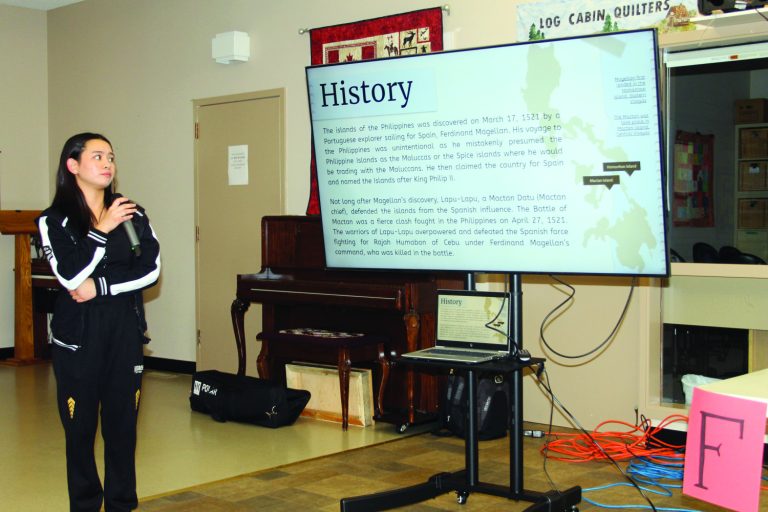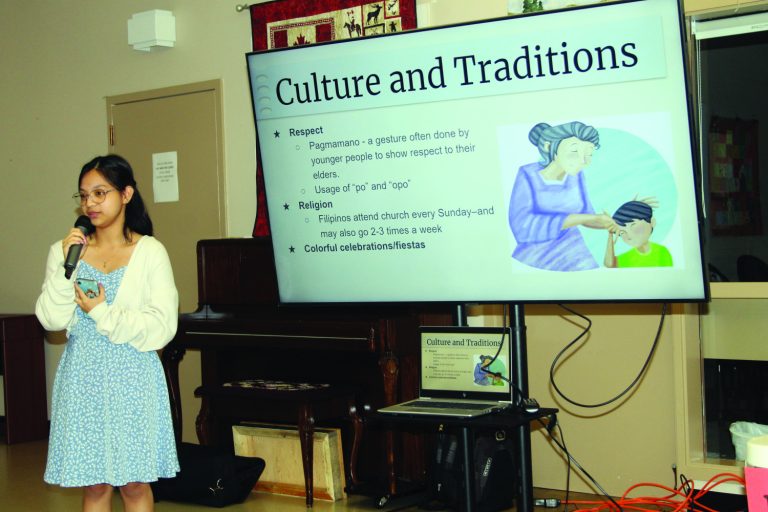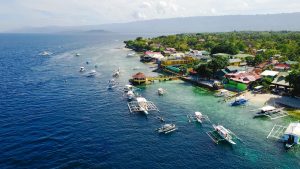Students discuss life in the Philippines at Claresholm Social Centre
By Rob Vogt
It was an opportunity for everyone to learn more about the culture of the Philippines from three students who are actually from that country.
On Tuesday, Sept. 26, about 16 people attended the first in a cultural series held at the Claresholm Social Centre. It was a presentation by Jillian Castro, Aldrean Cristobol, and Jasmine Santos who are all from the Philippines.
Shannon Yates, of the social centre, said one of the centre’s objectives is to provide and promote educational opportunities for all ages and cultures in the community.
One day through some brainstorming, they came up with the idea of a cultural series.
Yates explained since 2020 with the Rural and Northern Immigration Pilot program, Claresholm has welcomed about 120 newcomers from more than 15 countries around the world.
The centre then approached Alysa Fisher, the English as an Additional Language teacher at Willow Creek Composite High School, to see if she would be interested in collaborating on a cultural series involving students.
They were interested, and thought they would start with the Philippines as there is a significant number from that country in the school and the community.
Fisher said there are a number of students who speak more than two languages at the school.
This group started their project in April or May.
They began by talking about the history of the Philippines
It was discovered on March 17, 1521 by Ferdinand Magellan, a Portuguese explorer sailing from Spain. His voyage to the Philippines was unintentional as he thought the islands were Moluccas or Spice Islands. He then claimed the country for Spain and named it after King Philip II.
Not long after Magellan’s discovery, Lapu-Lapu, a Mactan datu or chief, defended the island from Spanish influence. The Battle of Mactan was fought on April 27, 1521 and the warriors of Lapu-Lapu overpowered and defeated the Spanish force fighting for Rajah Humabon of Cebu under Magellan’s command.
Manila is the capital of the Philippines, founded on June 24, 1571 by conquistador Miguel Lopez de Legazpi. It was the capital even before the colonizers came because of its strategic location in the middle of the biggest island and its rich fishing grounds and plains. It is most famous for the colonial architecture of Intramuros.
They then talked about Jose Rizal, who lived from 1861 to 1896, and is a national hero. He was a patriot, physician and novelist, best know for his political writings that inspired the Philippine revolution. He was later executed by the Spanish colonizers.
The Philippines has two seasons. The dry season, or tag-araw, goes from December to May, while the rainy season, or tag-ulan, goes from June to November.
Then they shared some of the culture and traditions.
There is respect. Pagmamano is a gesture often done by younger people to show respect to their elders.
There is religion. Filipinos attend church every Sunday, and may also go two to three times a week.
There are colourful celebrations and fiestas.
The Philippines is family-oriented. Filipinos value the idea of family as one unit, and family is always put first.
Filipinos are also hospitable and practise “bayanihan”, which is the act of Filipinos helping each other without expecting anything in return.
They talked about languages and dialects. In the Philippines, they speak more than 180 different languages and dialects. The Tagalog language is the one most Filipinos speak, but many people are bilingual or multilingual, speaker their mother tongue, Tagalog and/or English.
The main or top three religions in the Philippines are Roman Catholic at 78.8 percent of their population; Islam at 6.4 per cent; and Iglesia ni Cristo at 2.6 per cent Catholicism spread during the Spanish colonialism, and has remained the main religion since.
The Ati-Atihana Festival is the third Sunday in January, and is the “Grandfather of festivals”. People parade on the streets with colourful paints on their faces and wearing Indigenous costumes. Highlights include loud chants and drum beats, tribal dances, and Catholic rituals.
The MassKara Festival, in October, is a giant masquerade where locals wear colourful masks with flowers, feathers, beads and paints.
The Aliwan Festival in April is the “Mother of all festivals”, and is popular among Filipinos and international travellers.
The Kadayawan Festival in the third week of August has festivities that include street dancing, beauty pageants, floral floats, and firework displays.
Panagbenga or the season of blooming in February, is one of the longest festivals running the entire month.
The Philippines has its own dances too.
Tinikling is the national dance, performed using baboo poles, originates from the province of Leyte, and the movements are inspired by birds.
The Cariñosa can be translated to loving or affectionate one, represents the courting phase of a romantic relationship, and also celebrated Maria Clara, who is known as the ideal Filipino woman.
Music in the Philippines is very diverse. There is original pinoy music; some traditional folk music; and instruments include kutyapi, a two-stringed lute; dabakan, which is a single-headed drum; and gandingan, which has four hanging gongs.
The Philippines has its own unique food as well.
Chicken Adobo is one of the most well-known dishes. Its sauce is made up of vinegar, soy sauce, garlic and pepper.
Leche Flan is a custard dessert made of pudding and caramel, and Kare-Kare is a stew with vegetables, oxtail and a thick peanut sauce.
Schools in the Philippines typically start at 7:30 a.m.,end at 3 p.m. to 5 p.m., and students would have seven to eight classes a day.
Extracurricular activities are mainly sports and school clubs.
Every morning an assembly is held where students participate in the national anthem, called “Lupang Hinirang”; a patriotic oath, called “Panatang Makabayan”; a prayer; announcements; and, depending on the school, a school anthem or song.



